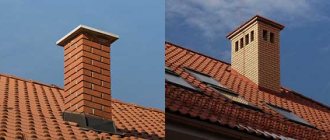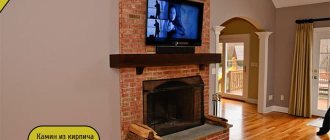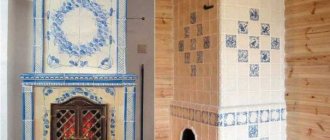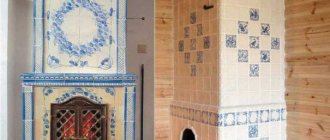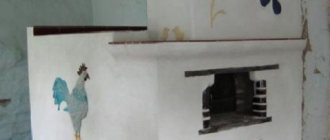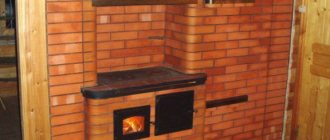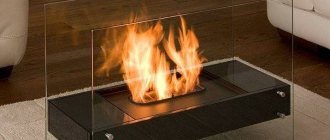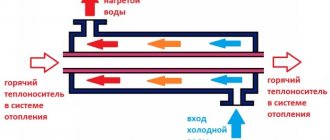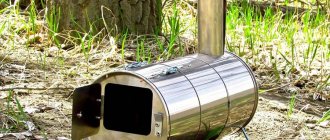A potbelly stove is often used to heat temporary buildings, garages, greenhouses, and utility rooms. But it also emits combustion products, a lot of smoke from burned wood or other fuels.
Therefore, you will need to decide how to make a chimney for a potbelly stove and where it is best to install it so that it is inexpensive and effective. Moreover, you can do it yourself. Moreover, everything is not as complicated as it might seem at first glance.
To make it easier for you to understand the assembly and installation of the chimney, in this article we looked at the step-by-step process, starting with the selection of material and assembly and ending with checking the functionality of the already installed system.
Purpose of a chimney in a stove-stove
Despite the apparent simplicity of the design, the chimney for a potbelly stove is a responsible device that performs two serious tasks:
- Provides removal of fuel combustion products, the temperature of which can range from 600 to 950 ºС.
A modern potbelly stove with a chimney provides efficient heating of the room and fits harmoniously into the interior - Provides room heating, heating significantly under the influence of exhaust gases. The efficiency of heat transfer depends on the location of the stove, the shape and length of the chimney.
A properly manufactured and installed chimney increases the efficiency of the stove by increasing the duration of flue gas removal. This is achieved by making a smoke channel with numerous curved elbows.
Considering the seriousness of the tasks performed by the chimney, increased attention is paid to its correct manufacture and installation.
The need to install a heat exchanger
If the stove pipe through which hot gases pass becomes excessively hot, you can cool it by installing a heat exchanger . In this case, excess heat will be used rationally. Such a device can operate in two modes. In the first case, a container filled with cold water is connected to it. As a result of the formation of a temperature difference, condensation occurs, which helps to warm up the device with steam. In this mode, the pipe walls heat up to 100 °C.
Another option for the heat exchanger to operate is to avoid steam condensation and increase the heating temperature of the pipe. According to the recommendations of experts, the heat exchange device in this case should function as a register for heating the liquid.
Calculation of the main parameters of the chimney
Before carrying out work on the manufacture of a chimney, it is important to accurately determine the diameter of the outlet pipe for the potbelly stove. The efficiency of the heating device, as well as fuel consumption, depend on the correctness of the calculations.
The calculation method is quite simple. You should multiply the volume of the combustion space by a coefficient equal to 2.6–2.7. The resulting value corresponds to the internal diameter of the chimney.
For example, for a potbelly stove with a firebox volume of 50 liters, a pipe with an internal diameter of 135 mm will be required to exhaust smoke. The volume of the firebox can be calculated by measuring its dimensions or found out from the technical data sheet, in which this value is indicated by the product manufacturer.
If the chimney of a potbelly stove is intended not only to remove combustion products, but also to increase the temperature in the room, when performing calculations it is advisable to provide for the installation of several elbows. Each section should be located at an angle and have a length of no more than one meter.
At the design stage, it is advisable to develop a sketch of the chimney.
If the chimney is discharged through the roof, it is important to provide for an elevation of the upper part of the smoke line above its roof level by 0.5–1 m.
If the chimney is installed at a distance of up to 50 cm from the ridge, it is made 50 cm higher than the roof, otherwise it can be located at the level of the ridge or even lower
When calculating the chimney configuration, keep in mind that the distance from the stove to the first turn of the pipe must exceed 1 meter. This will allow the smoke to leave the firebox freely and not accumulate inside the room.
Maintaining a distance of at least 1 m from the stove to the bend of the pipe will ensure normal smoke removal
Based on the results of the calculations, it is easy to draw up a connection diagram or sketch indicating the dimensions of the pipes.
The drawn up diagram will help you calculate the need for materials and assemble the chimney yourself
Step-by-step installation of the channel
- That part of the pipe, which is assigned the role of the lower structural element, is attached to the corresponding hole in the potbelly stove.
- The following parts of the chimney are installed on the lower pipe using butt elbows. This design extends to the ceiling.
- A hole is made in the ceiling in accordance with the diameter of the pipe. In this case, the area around it should be cleared of the heat-insulating material laid during the construction of the roof. Such measures are required to prevent the occurrence of a fire hazard.
- After equipping the hole, a pass-through glass is inserted into it, through which a pipe is pulled from the room and connected to an already prepared structure intended for external installation. Thus, the chimney for the potbelly stove is constructed. The height of this device should exceed the roof level by about 10 cm.
- Thermal insulation of the chimney is ensured by treatment with bitumen resin and a material intended for this purpose, for example, mineral wool. The so-called saucer will serve as protection for the thermal insulation layer in the event of possible escape of hot ash particles from the chimney.
- A special metal fungus, which should be equipped with the end of the pipe, will prevent rainwater and foreign objects from entering the channel for the potbelly stove and causing clogging.
- After final assembly of the structure, all seams and joints of individual elements must be generously lubricated with fire-resistant sealant. Thus, smoke from the chimney will not penetrate into the room.
- When the composition is completely dry, you can start lighting the stove to check the joints for tightness.
Requirements for garage chimneys
Special requirements for installation work and operation of chimneys in garages are related to the need to ensure fire safety.
Flammable liquids should not be located near the stove
When connecting and testing the chimney of a garage stove, pay attention to the following points:
- Effective functioning of natural ventilation or the presence of a forced air supply system in the garage. This is necessary for the uninterrupted combustion of fuel in a potbelly stove, for combustion of which air must enter the firebox through a slightly open vent.
- There are no objects prone to ignition near the chimney and the body of the heating device. The possibility of fire as a result of increased temperature during testing and further operation of the furnace should be excluded.
- Location of storage areas for flammable liquids, fuels and oils. They should be at a sufficient distance from the stove.
Following these simple recommendations will allow you to avoid fire hazards, ensure personal safety and, while in the garage, enjoy working in a warm room.
Video: chimney and ventilation in the garage
Channel output circuits
The choice of one of the options for installing a chimney for a potbelly stove is influenced by the preference for the location of the pipe outlet.
For this purpose, the following three possible schemes are proposed:
- If the channel for the potbelly stove comes out through the ceiling and roof , then an energy-saving design is used, due to the arrangement of which heat is expected to be transferred, including from the chimney crossing the room vertically. The complexity of installation and the need to ensure an adequate level of fire safety are among the disadvantages of using such a scheme.
- If the pipe for the potbelly stove is meant to exit through the wall a quarter of a meter up to the ceiling level , in this case an additional heat source is also formed. This function is performed by the part of the pipe located in the room itself. Due to this, the efficiency of the furnace increases, and at the same time less fuel is used.
- In the case of a chimney outlet to the street through the wall directly from the stove, the channel for the potbelly stove is located vertically outside the building. This scheme is convenient in that fire safety measures are observed, but the room receives less heat, which means greater fuel consumption.
Features of the operation of chimneys for potbelly stoves
When operating chimneys, it is necessary to ensure fire safety associated with heating the pipes to high temperatures. When thinking about the safe operation of hot chimneys, follow these recommendations:
- Place chimneys at a safe distance from people's routes. It is important to ensure that there is no possibility of injury or contact with a hot surface.
- Use connecting cups to join pipes in the overlap area. Provide thermal protection at the ceiling level using heat-insulating materials.
- When operating the potbelly stove, pay special attention to the presence of draft. A decrease in draft indicates a violation of the tightness or the formation of a significant soot deposit inside the chimney.
- During operation, adjust the damper to increase the burning time and reduce the outflow of smoke into the main line.
- The maintainability of the chimney is one of the important operating conditions. The location of the pipes should allow the damaged element to be quickly disconnected while maintaining the integrity of the entire structure.
When using the chimney, no unforeseen situations will arise if you strictly adhere to the necessary recommendations during installation.
Is it worth covering the pipe with bricks?
A metal chimney pipe for a potbelly stove does not require special protection from external influences, but due to the visual effect and possible contact with a hot pipe, enterprising owners often line the pipeline with bricks.
Expert opinion
Pavel Kruglov
Stove maker with 25 years of experience
But the construction of a chimney using brickwork is prohibited - such structures are not suitable for this heating system; only a galvanized pipe for a potbelly stove is suitable for this role, it will provide good draft, it is easy to clean and check for defects. Simplicity of installation and easy maintenance are the main advantages of this hood.
Chimney cleaning and repair
Safe, long-term and economical operation of the stove depends not only on the correct installation of the chimney. It is important to carry out timely measures to clean the chimney, and also, if necessary, to repair and restore failed elements.
Care requirements
The measures include regular performance of the following chimney maintenance work:
- Annual visual inspection of the chimney. This will allow you to identify pockets of rust in a timely manner and promptly take measures to treat the surface and protect against corrosion. Depending on the degree of damage, the defective chimney element must be restored or replaced.
- Cleaning the inner surface of the pipe from accumulated deposits. The design makes it difficult to use a traditional weight and cleaning brush to mechanically remove soot. At least twice a year, use special chemical compounds that remove soot when burned together with firewood. Periodic burning of aspen logs helps remove deposits in pipes.
Timely maintenance will ensure safe operation and will not allow combustion products to unexpectedly enter the room.
Repair recommendations
Repairing your pipe will help you avoid serious problems. Even a properly designed and timely maintained chimney can fail.
Metal chimneys have increased reliability. However, with prolonged use, burnouts and cracks form on individual elements.
A burnt-out chimney poses a serious danger, so the failed section of the pipe must be urgently replaced
The essence of repair is the timely replacement of damaged elements. It is not necessary to completely dismantle the entire pipe; it is enough to remove the damaged section and replace it with a new one. Remember that during the repair process you should be careful; it is important to maintain the integrity of the pipe, consisting of individual modules. After replacing the damaged part, seal the joints.
Service
To ensure safe operation of the stove, you need to systematically carry out preventive maintenance, i.e. check the chimney for cracks or burnt areas. Detected faults must be eliminated by replacing the part of the pipe with the defect with a new piece.
To ensure good traction, timely cleaning of the internal space of the pipe from soot is also necessary. When using solid fuel (coal, firewood), its accumulation occurs quickly. Cleaning and maintenance is carried out by burning special briquettes, aspen firewood or mechanically.
DIY potbelly stove from Dimon
Factors influencing indicators
Regarding the parameters of the chimney pipe, it is impossible to say that the higher it is, the more preferable. An extremely long or wide flue increases the cost of building chimneys. A boiler or stove with such a chimney will begin to wear out when there is excess draft, the fuel will be burned quickly, and a significant part of it will be uselessly released into the atmosphere, reducing the efficiency of the heating system.
The cross-sectional size only partially affects the length of the chimney pipe. In other words, the user will not be able to increase its diameter to increase efficiency. In this connection, experts do not advise experimenting with the cross-sectional sizes of stove pipes, adjusting them to certain height indicators, for example, making them below 5 m or above 7 m. The draft will be the same throughout the entire structure; on the contrary, a very large pipe diameter can reduce the draft, from - for turbulence, tearing the torch away from the gas nozzle.
Calculating the length of the pipe depends more on the height of the object on which it is placed and the type of roofing. The indicator above the roof level is a more important indicator for calculating the optimal pipe section.
Calculation of the chimney diameter for the stove
The length of the chimney pipe from the grate to the exit point must be at least 5 m. If the roof is made in the form of a flat structure, then the height of the pipe must be at least 50.0 cm. On pitched structures, when it is located at a distance from the ridge to 1.5 m, it must rise at least 50.0 cm in relation to the outer or enclosing parapet. If it is located within 1.5–3.0 m from the ridge, then its top should not be lower than it or the parapet.
In some cases, the pipe is located further than 3 m from the ridge line, then its minimum height is calculated at an angle of 10 degrees relative to the horizon. In case there are large high-rise buildings nearby, and the boiler or fireplace runs on wood, then the height of the chimney is chosen higher than the roof of nearby houses.
Recommendations for pipe placement and construction:
- There is no need to install chimneys close to the attic windows so that the occasional wind does not blow combustion products into the attic.
- It is also not recommended to install exhaust pipes and ventilation ducts in the valleys, so as not to create snow pockets.
- When the outer section of the chimney exits, there is no need to rigidly strengthen it with the roof structure and rafters, since if the pipe collapses in a hurricane, the entire roof will be damaged.
A competent calculation of all the characteristics of the future chimney exhaust system is a guarantee of its performance and the efficient operation of all boiler equipment. A lack of calculations, which can be made at the design stage, will lead to an emergency mode with subsequent destruction of the system. Simple calculations, based on the long-term experience of specialists, enable the user to perform them efficiently to determine the technical parameters of the chimney pipe.
Warm brick
A potbelly stove using wood, coal and other types of fuel can significantly increase its efficiency. To do this, it is enough to build a screen of baked clay bricks around it with your own hands. If you look carefully at the drawings of such a mini-building, you will see that the bricks are laid at a short distance from the walls of the stove (about 10-15 cm), and, if desired, around the chimney.
Bricks require a foundation. Do you want the masonry to last a long time? Then fill the base one at a time to form a monolith. It is better to take concrete as the material for the foundation, which should be reinforced with steel reinforcement yourself. It is advisable to place the reinforcement layer at a distance of approximately 5 cm from the surface of the concrete pad.
Ventilation holes are made at the bottom and top of the brickwork, which will ensure air movement (heated masses will go up, cold air flows will come from below). Ventilation also prolongs the life of the metal walls of the potbelly stove, delaying the moment of their burning due to cooling by circulating air.
Bricks laid around the stove accumulate heat and then release it for a long time, warming the air in the room even after the stove goes out. In addition, brickwork additionally protects objects surrounding the stove from fire.
If desired, you can completely lay out the stove from brick. Such a structure is advantageous in that it will last for many years without additional effort on the part of the owner. However, there are also certain disadvantages. The disadvantages of this option include the following:
- the process of laying out such a stove is quite labor-intensive and is suitable only for those people who have experience in masonry with their own hands;
- a brick stove is quite expensive, as it requires the use of fireproof materials, including fireclay bricks and special clay for mortar.
In order to get a small potbelly stove with wood, it is enough to lay out a cone measuring 2 by 2.5 bricks, 9 bricks high. In the combustion chamber, rows 2-4 are laid out of fireclay bricks. An ordinary fired clay brick is suitable for a chimney, into which you must remember to insert a stainless steel sleeve.
Whatever the method of making a miniature stove or potbelly fireplace with your own hands, whether you make them according to a drawing or by eye, the main thing is that at the end you get an effective heating device, and in an expanded configuration also a hob for cooking. Look around for suitable materials (barrels, sheet iron, etc.) and go ahead to your own homemade stove or even a potbelly stove!
How to make a wood splitter with your own hands? How to install a sandwich chimney with your own hands It’s not difficult to build a chimney for a boiler with your own hands Do-it-yourself metal stove How to make a smokehouse yourself at home or in the country
Calculation methods
Professionals use several methods for calculating chimney parameters. When installing large industrial pipes, designers are tasked with very complex calculations. They take into account:
- quantity and composition of flue gases;
- concentration of harmful substances in combustion products;
- pipe material;
- roughness of the internal surface of the hog;
- meteorological situation in the region.
The calculation of large pipes often serves as a topic for a thesis at an institute. Fortunately, the size of chimneys in a private house is smaller, and the power of heating units is also inferior to industrial facilities.
When designing a small pipe for a private house, simpler, although quite accurate, calculations are used. The chimney parameters obtained as a result of calculations ensure complete evacuation of combustion products from the firebox and ensure the safety of residents. Such calculations allow you to avoid errors in choosing parameters and when installing the chimney, and to avoid subsequent reworking of structures. Such alterations in an already built and finished house are much more difficult than during the construction process.
Exact method
For heating, ready-made industrial heating or heating and cooking units with a certain chimney diameter are often installed. With sauna heaters or oil stoves for garages, ready-made sandwich chimneys of small diameter (100 mm) are usually also installed.
For more accurate calculations, it is necessary to know the characteristics of the fuel and the heating boiler, the rate of rise of flue gases, the amount of fuel burned, the shape of the chimney (sectional shape, number of bends). The calculations are quite complex and require the use of some special data, so let’s consider the calculation for a wood-burning heating unit (fireplace) - they are often made original, relying only on the experience of the stove maker, so calculation of the cross-section is necessary.
Let the chimney have a round cross-section, without turns. Data for calculation:
the average speed of movement of flue gases along the hog v is taken equal to 2 m/s;
mass of firewood burned within an hour in the firebox – B=5 kg/h (humidity 25%);
temperature of exhaust gases – t = 160°С.
Which one is better to choose?
Factors:
- type of potbelly stove;
- volume of the furnace section;
- method of connection to the structure;
- indoor location;
- the need to carry the stove;
- chimney material;
- requirements for pipe design.
In fact, the chimney is selected for a specific type of stove, and not vice versa. Otherwise, the heating system will not operate properly. This especially applies to the requirement for a minimum pipe diameter.
If you have experience, you can make the required type of chimney yourself. But all basic rules for calculation and design must be strictly observed. If there is no experience or it is not enough to fully comply with all manufacturing and installation conditions, then it is better to order.
It is worth considering that installation work with existing material also has its own nuances and features.
The choice of material depends on the stove itself, as well as their availability. The choice of material is based on the required design features and the nature of the heating system, that is, whether it is stationary or mobile.
Stone or brickwork is used for permanent installations. A cheaper material would be a galvanized pipe, which has improved properties compared to ordinary sheet metal. It is this material that should be used for collapsible design options, as well as when it is necessary to conveniently replace segments.
The cheapest material is considered to be ordinary tin. There is a nuance here in the form of a requirement for the size of the wall. The pipe must be thicker than 0.5 cm, since otherwise it cannot be installed indoors according to fire safety regulations.
Drawing and diagrams
A drawing is a preliminary diagram in the form of a drawing. But it must indicate the actual required dimensions, which will help to carry out the correct installation based on all the rules and instructions. The drawing is made in any form before installation begins. It is required for installing a chimney according to the regulations of a mini construction project.
The entire system is built on the basis of a proportion of 1 to 2.7, since this is a prerequisite for full traction.
The volume is multiplied by 2.7 and we get the result in millimeters. Example: the oven has a volume of 50 liters. We multiply 50 by 2.7 = 135 mm. For convenience, you can add up to 5 mm, that is, a pipe diameter of 13.5 to 14 cm is suitable.
Installation features
Among the installation, there are several features that are taken into account when working. Rules:
- installation begins from the lower sections;
- the passage through the walls is treated with insulating materials until the pipe is installed there;
- the regulations for the location of joints relative to the walls and ceiling are observed;
- one diameter is used for the pipes of the entire chimney.
The main rule of installation is full compliance with all construction work and safety regulations.
Failure to comply with all regulations for the construction and arrangement of the heating system is also considered a problem. All these miscalculations affect the final result.
